We investigated 214 car modifications in our electric vehicle market research to find out and compare important features.
In our investigation, we looked at the popular body types, makes, and technical specs of electric cars. We also compared electric vehicle specs and features to cars with internal combustion engines to provide clear electric cars statistics.
In this article, we want to share this information with you.
Here are our key findings on electric cars:
- Only 5 companies out of 76 have produced per 4 or more models of electric car that have been serious competitors on the market.
- Electric vehicles accelerate, on average, 14.1% faster than cars with an ICE (internal combustion engine).
- On average, electric cars can drive 197 miles (316.9 km) without recharging.
- The average power of a modern electric car is 193.7 kW or 263.4 hp.
- On average, the maximum speed of a modern electric car is 104 mph (167 km/h).
- Electric cars use their engine power 2.57 times more efficiently than cars with internal combustion engines.
- Out of cars with a high battery capacity, 10 best ones can go 322.9 miles (519.7 km), on average, without recharging.
- About a third of electric vehicles are equipped with four-wheel drive.
- A total of 29.4% of all electric vehicles are hatchbacks.
- On average, an EV consumes 18.1 kWh per 60 miles.
- New electric cars use their battery charge less efficiently than the very first electric vehicles.
Let’s expand on each point of our market analysis of electric vehicles in more detail:
Only 5 companies have produced 4 or more models of electric vehicle
The statistics about electric cats shows such market leaders in terms of models:
- Volkswagen – 7 models (Golf, Up!, ID.3, ID. Vizzion, Lavida, ID. Buzz, ID. Crozz)
- Audi – 5 models (PB 18, e-tron, e-tron GT, Q4, e-tron Sportback)
- Peugeot – 5 models (2008, Partner, iOn, 208, e-Legend)
- Citroën – 4 models (Berlingo, C-Zero, e-Mehari, Ami)
- Renault – 4 models (Twingo, Kangoo, Zoe, City K-ZE)
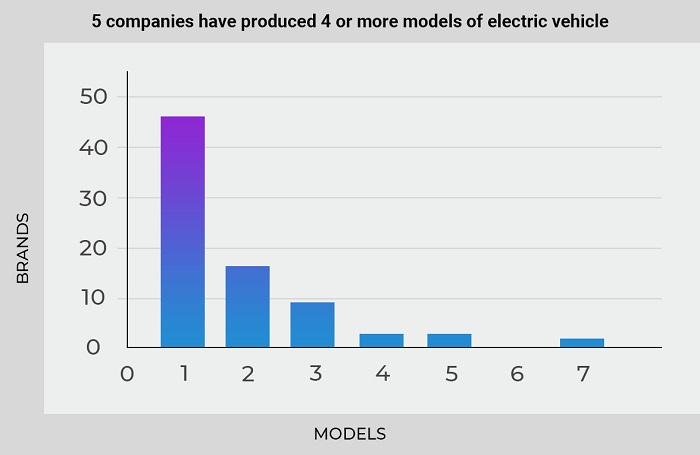
EV market distribution:
- 46 producers offered 1 model only
- 16 companies offered 2 models of electric cars each
- 9 companies produced 3 models of EVs
- 2 companies offered 4 models
- 2 companies produced 5 models
- The leader, Volkswagen, offered 7 models
European manufacturers in general are producing more electric models, and the overwhelming majority of companies produced 1 electric car each. This suggests that the market is gaining popularity, but many companies are not rushing into investments in this area. Even the largest corporations only produced between 4 and 7 models, including concepts. We show it in our graphs about the electric cars stats.
Only 5 out of 76 companies have produced 4 or more models of electric car and were serious competitors in this market.
Electric vehicles accelerate to 60 mph in 7.24 seconds on average
On average, acceleration to 60 mph takes 7.24 seconds for electric vehicles (7.63 seconds to 100 km/h). For internal combustion engines, the average is 8.43 seconds to 60 mph. That is, electric cars accelerate, on average, 14.1% faster than cars with internal combustion engines.
We divided electric vehicles into three groups. In the first one, we put the 48 fastest cars and in the third one, the 48 slowest. The second group contains the 50 cars with average acceleration.
Average specifications for groups:
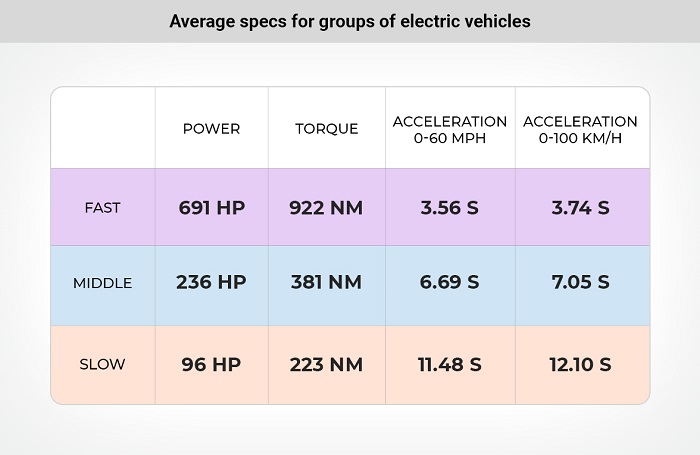
From fast to medium cars, the power drop is 65.8%, the torque drop is 58.7%, and the acceleration drop is 46.9%.
From medium to slow cars, the power drop is 59.3%, the torque drop is 41.5%, and the acceleration drop is 41.7%.
It can be seen from the table that changes in electric vehicle power have a greater effect on acceleration than changes in torque.
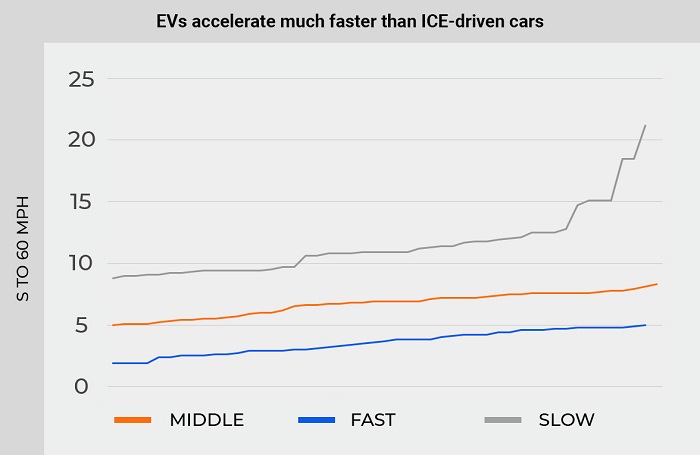
Electric cars accelerate significantly faster than cars with internal combustion engines. Obviously, this is due to the earlier maximum torque of electric motors, as well as the features of the gearbox, which in most cases are continuously variable for electric cars.
On average, electric cars can drive 197 miles (316.9 km) without recharging
We compiled the rating of electric cars by range. The average distance on a single charge is 316.9 km (197 miles). At the same time, 25 cars, or 11.9% of all cars on the market, go more than 500 km (311 miles), and 29 cars, or 13.8% of all cars on the market, can go less than 150 km (93 miles) on one charge.
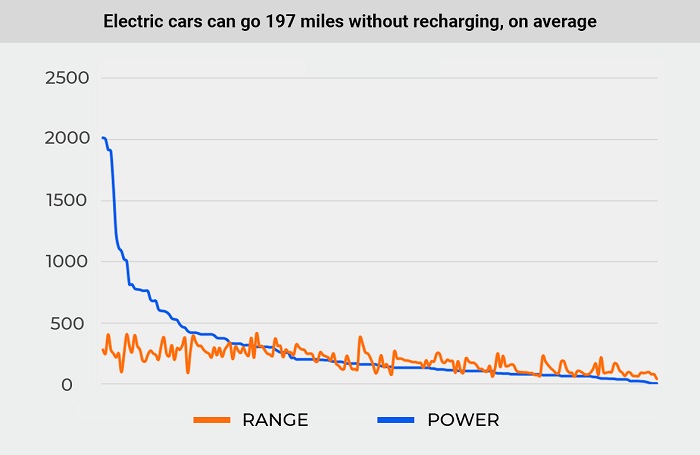
Driving range is the most important specification for electric vehicles. Manufacturers are investing billions of dollars in developing technologies to improve this indicator, but so far cars have not shown a significant increase in efficiency, and about 15% of modern electric cars have city-only status with less than a 100-mile range on a single charge.
The average ratio of power to weight of electric cars is 7.92 kg per 1 kW
We found that the average power of a modern EV is 193.7 kW or 263.4 hp.
The average weight, according to our samples, is 1535 kg.
The average weight-to-power ratio is 7.92 kg per 1 kW or 5.82 kg to 1 hp.
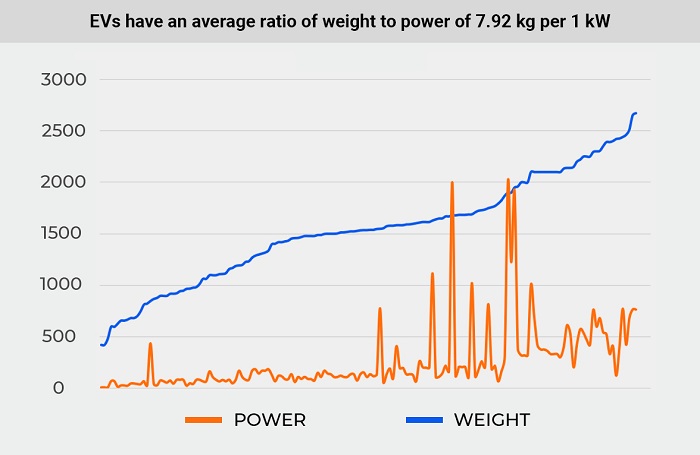
The more kilograms there are for each kilowatt of power, the more difficult it is for the car to accelerate. It also affects top speed, energy consumption, and overall driving pleasure.
The average power of cars with internal combustion engines is 173 hp or 129 kW, and the average weight is 1484 kg. That is, electric cars are 3.4% heavier and 50.2% more powerful. For cars with internal combustion engines, on average, 1 kW of power accounts for 11.5 kg of weight. You will clearly get more pleasure from driving an electric car – it will accelerate better and give you more confidence when overtaking.
The average top speed of an electric vehicle is 104 mph (167 km/h)
On average, the maximum speed of a modern electric car is 104 mph or 167 km/h.

The 5 fastest electric cars have an average power output of 1487 hp. For the slowest cars, this figure is 22.6 hp.
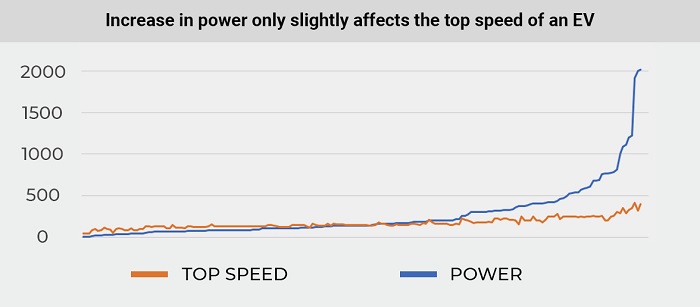
Electric cars use engine power 2.57 times more efficiently than cars with internal combustion engines
The torque of a car with an internal combustion engine in Nm is, on average, 49.1% higher than the power in hp.
For electric vehicles, torque is, on average, 126.3% higher than power. At the same time, there are cars that show a negative result – that is, their power in hp is higher than their torque rate.
So, electric vehicles are 2.57 times more efficient in using the potential of the engine to obtain optimal torque.
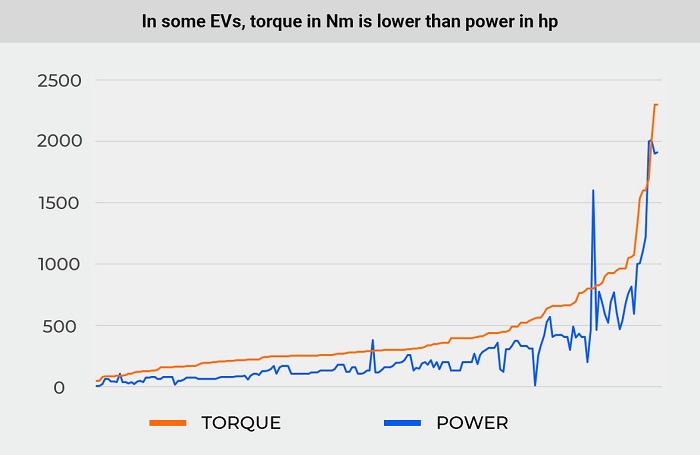
Manufacturers of powerful electric supercars are forced to limit torque artificially. This is obvious when considering the power-to-torque ratio on electric motors over 500 hp. Smooth torque output from 0 rpm to maximum engine revolutions is an important advantage of electric vehicles over traditional cars with gasoline or diesel engines.
Out of cars with the highest battery capacity, 10 best ones cover 322.9 miles, on average, without recharging
From the sample, 14 cars – or 6.8% – have a battery capacity of more than 100 kWh.
At the same time, 38 cars – or 18.4% – have batteries with a capacity of less than 20 kWh.
The average battery capacity of a modern electric car is 51.03 kWh. On average, this capacity is enough for 196.9 miles of driving without recharging. Look at battery rating for electric cars in our charts.

We found that 10 cars with a high battery capacity can drive a total of 3229.3 miles on a single charge, or 322.9 miles per car. This is 39.6% more than the market average.
The 10 cars with the smallest batteries can cover 755 miles in total on a single charge or 75.5 miles per car. This is 61.3% less than the market average.
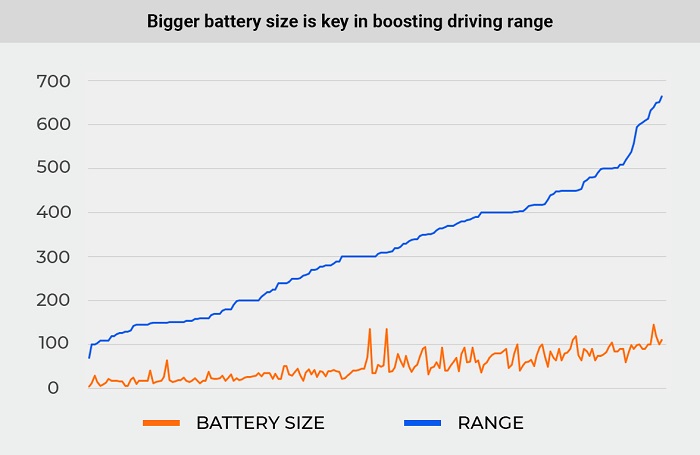
Battery capacity significantly affects the driving range without recharging. An additional 50% battery capacity increases the average mileage by 50%. But keep in mind that the range depends on the use of electrical appliances and engine power as well as the style and conditions of driving and even the air temperature.
About a third of all electric vehicles are equipped with four-wheel drive
Out of 207 electric cars:
- there are 63 with four-wheel drive (30.4%)
- there are 101 vehicles that offer front-wheel drive (48.8%)
- a total of 43 EVs are equipped with rear-wheel drive (20.8%)
Nearly half of all electric vehicles are manufactured with front-wheel drive.
Around a third of all electric cars are equipped with four-wheel drive.
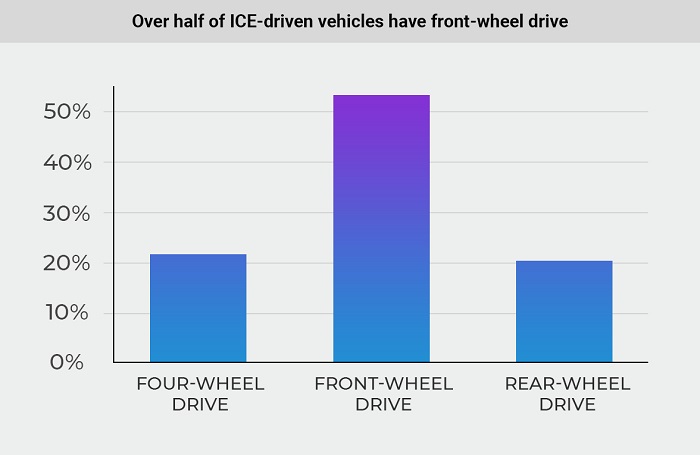
We looked at the data on cars with internal combustion engines for comparison:
- four-wheel drive – 22.4%
- front-wheel drive – 56.8%
- rear-wheel drive – 20.8%
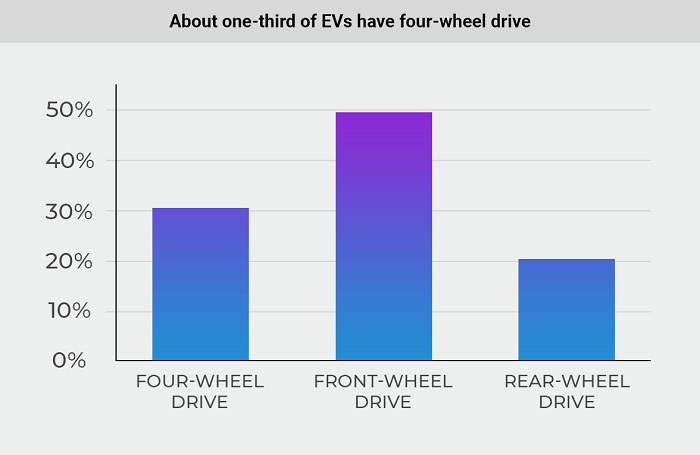
Surprisingly, the proportion of rear-wheel drive vehicles is identical for cars with internal combustion engines and electric vehicles.
The proportion of cars with AWD among electric cars is 8% more than among cars with internal combustion engines.
We also calculated the average year of launch of electric vehicles with different drive types and saw the following results:
- four-wheel drive – 2018
- front-wheel drive – 2017
- rear-wheel drive – 2016
Statistics show that, initially, manufacturers tended to equip cars with rear-wheel drive, but as technology developed, they started using the more common front-wheel drive for passenger cars.
Four-wheel drive is the most recent drive type for electric cars.
Electric cars are marketed as high-tech cars. Probably, the rapid growth in the number of four-wheel-drive cars is a marketing ploy. Given the average ground clearance of electric cars of 143 mm, these cars are clearly not intended for off-road use.
A total of 29.4% of all EVs are hatchbacks
Electric vehicle body types are divided as follows:
- Hatchbacks make up 29.4% of the electric car market
- Crossovers and SUVs account for 25.9% of the EV market
- Another 14% are accounted for by the coupe
- Sedans are fourth – their share is 11.2%
- Minivans round out the top 5 – there are 7.7% of them among EVs
- Another 11.8% can be accounted for by other body types
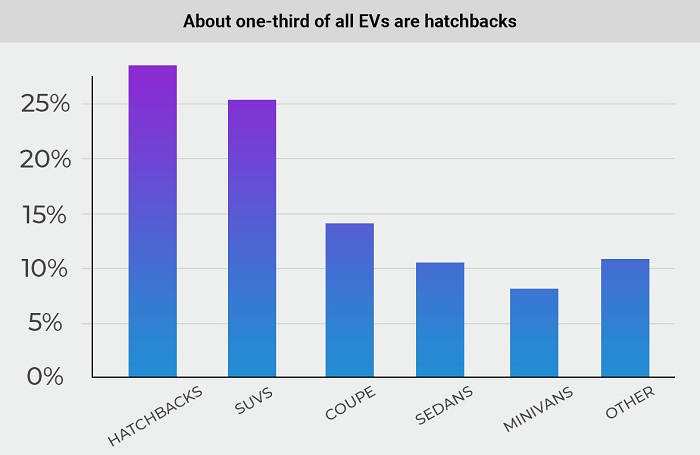
However, of the 10 newest electric cars, 7 are SUVs, 2 are hatchbacks and 1 is a grand tourer. That is, manufacturers have totally switched to the crossover market, obviously considering this to be the most profitable.
Distribution of electric vehicles by body type:
- Cabriolet – 3
- Coupe – 20
- Coupe, SUV – 2
- Fastback – 2
- Grand tourer – 1
- Hatchback – 42
- Liftback – 3
- Minivan – 11
- Pickup – 1
- Roadster – 2
- Sedan – 16
- Station wagon – 1
- SUV – 37
- Unstated – 1
Initially, hatchbacks were the most popular electric vehicles: of the first 10 electric cars produced, 8 were hatchbacks. But today, the evolution of electric vehicles toward crossovers is obvious, and their popularity is growing.
On average, an EV consumes 18.1 kWh over 60 miles
Calculating the energy consumption of electric vehicles is difficult since it is impossible to equip a car with a device to accurately determine the consumption at any given moment. Manufacturers often do not provide such important information as electricity consumption per 100 km or 60 miles, so we have calculated this specification ourselves.
To the basic calculation formula (battery capacity divided by 100 kilometers of maximum driving range without recharging), we added 20% as a reserve for lighting devices, music, and the operation of climate-control systems.
Our formula:
battery capacity / (driving range / 100) + 20%
Here’s our energy usage rating for electric cars. According to our data, a modern electric vehicle uses an average of 18.1 kWh per 60 miles. This means that one kilowatt is enough for 3.3 miles on average.
The Rivian R1T has the highest consumption at 52.2 kWh per 60 miles. Among mass-produced electric vehicles, the Citroën e-Mehari consumes the most – 34.8 kWh per 60 miles.
The lowest fuel consumption was recorded at 5.5 kWh at 60 miles for the electric vehicle Aixam eAIXAM.
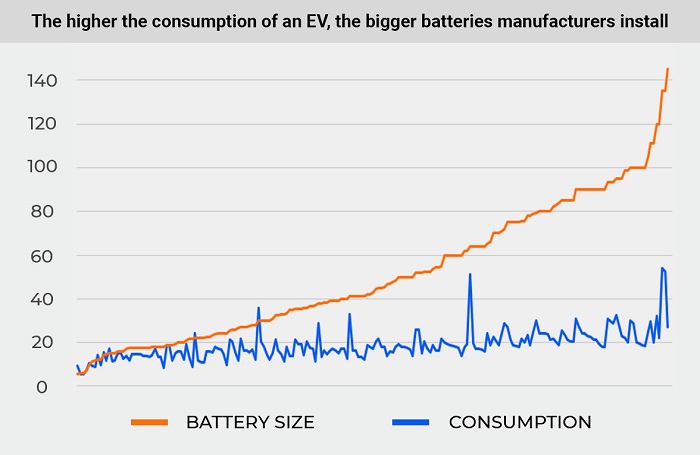
Top 5 most energy-efficient electric vehicles:
- Aixam eAIXAM – 5.5 kWh per 60 miles
- Citroën AMI electric – 9.1 kWh per 60 miles
- Renault Zoe I – 10.6 kWh per 60 miles
- Baojun E100 – 11.1 kWh per 60 miles
- Citroën C-Zero – 11.2 kWh per 60 miles
The most wasteful mass-produced electric cars:
- Citroën e-Mehari – 34.8 kWh per 60 miles
- Mercedes-Benz V-class eVito – 31.9 kWh per 60 miles
- Audi e-tron Sportback – 31.5 kWh per 60 miles
- Porsche Taycan 4S Performance – 29.7 kWh per 60 miles
- Tesla Model X P100D – 28.9 kWh per 60 miles
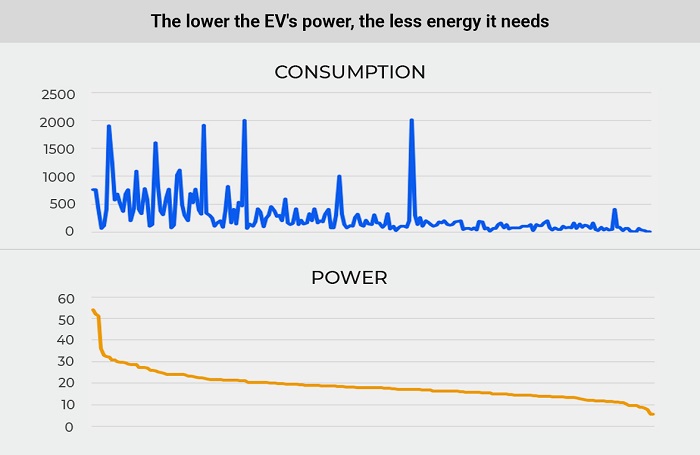
If you know the real energy consumption of an electric vehicle, you can easily calculate the cost of a trip in it. It is also a key factor for assessing the cost of using different electric vehicles and for comparing their performance.
New electric cars are more powerful, but they use their batteries less efficiently
We have sorted electric vehicles by selecting the 10 oldest and 10 newest vehicles on the market. The older ones entered the market between 2009 and 2013, the newer ones between 2020 and 2021.
The average power among the 10 oldest electric cars is 161 hp. The 10 newest EVs have an average power of 193.8 hp, which is 16.9% higher.
On average, the first electric cars covered 149.8 miles (241 km) without recharging, and the average battery capacity was 33.1 kWh. For the latest electric vehicles, the mileage on a single charge increased by 15.6% to 173 miles (278.5 km). But the battery capacity also increased by 39.6% to 46.2 kWh. That is, newer electric vehicles are generally less efficient at using battery capacity for a long trip on a single charge. It appears to be the statistics for inefficiency of electric cars.
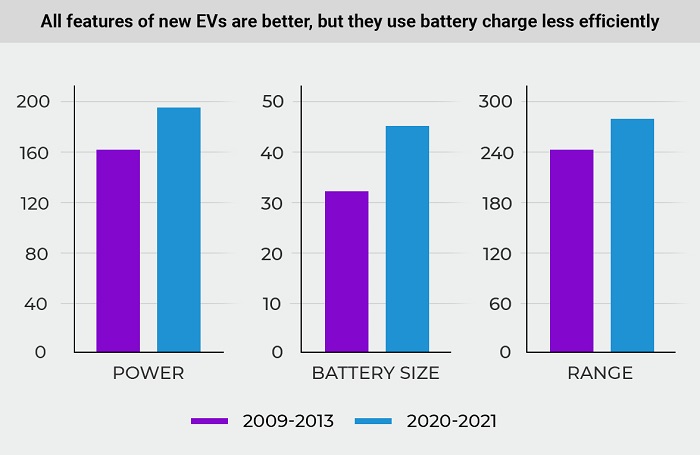
Over their 12 years of production, manufacturers of electric cars have increased power and battery capacity. But it is clear that technology has not become more efficient. The batteries have more capacity, but they are barely able to deliver the same driving range with a single charge as they were 12 years ago.
All data of our investigation are available in this file.
Thank you for reading our electric cars industry analysis and research. We hope it answered your questions about modern electric vehicles. If you have something to add to the information in this study, please leave a comment below.
About the authors
The CarAraC research team is composed of seasoned auto mechanics and automotive industry professionals, including individuals with advanced degrees and certifications in their field. Our team members boast prestigious credentials, reflecting their extensive knowledge and skills. These qualifications include: IMI: Institute of the Motor Industry, ASE-Certified Master Automobile Technicians; Coventry University, Graduate of MA in Automotive Journalism; Politecnico di Torino, Italy, MS Automotive Engineering; Ss. Cyril and Methodius University in Skopje, Mechanical University in Skopje; TOC Automotive College; DHA Suffa University, Department of Mechanical Engineering




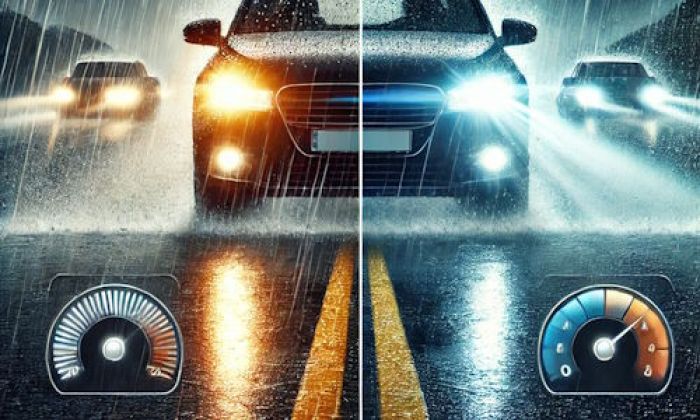
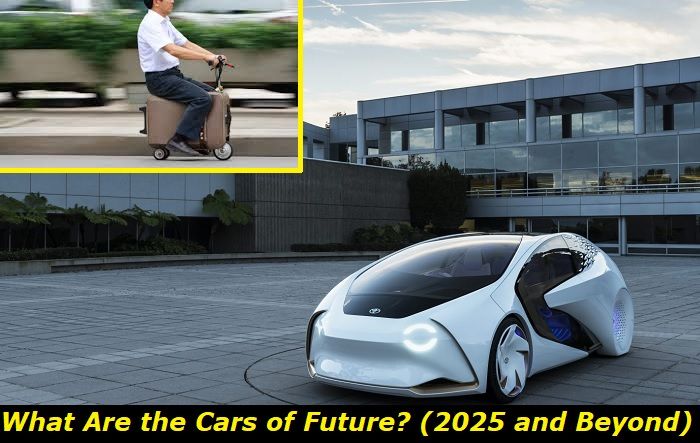
Add comment